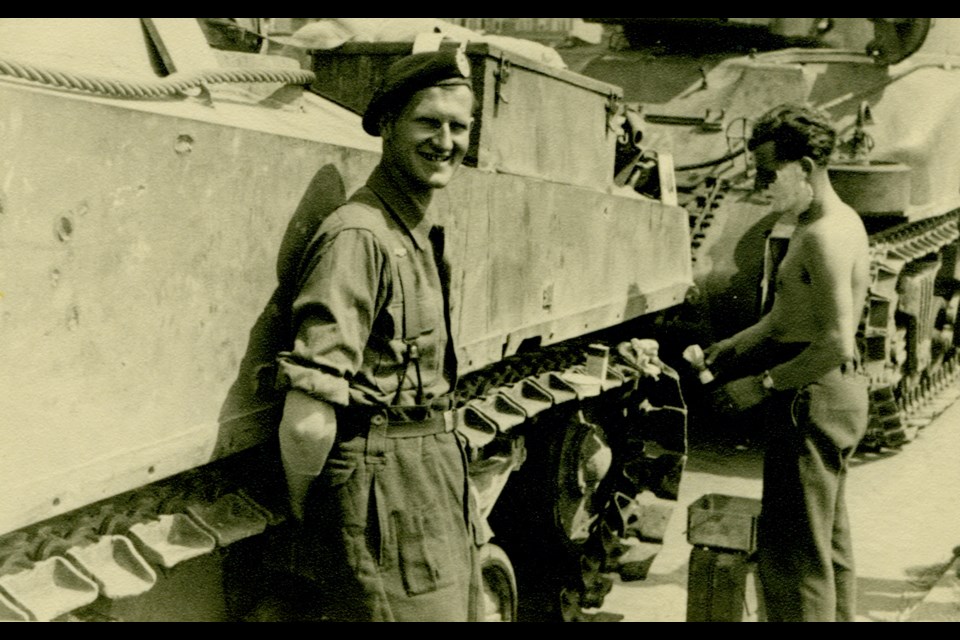November 11 is the date in 1918 when the armistice was signed between the Allies and Germany to end World War 1. The four-year war saw over eight million deaths, one of the deadliest conflicts in history. Although it became known as the War to End All Wars, world peace was short-lived; global conflict broke out again 21 years later. World War 2 lasted six years and resulted in over 60 million fatalities — a number that is almost double Canada’s population.
To most, these are just facts and dates and figures learned from history books, perhaps made more real only by family stories or research and contemporary films — but for 97-year-old Caslan resident Glen Meyer, it’s different.
He was there.
Editor’s Note: The Lac La Biche POST ran this story originally in 2011 with Alina Smirnova as the writer with files from Rob McKinley. We bring it back now to remind our regional readers of the personal toll war can take. Glen Meyer still lives in the Lakeland region and was a special guest at Remembrance Day ceremonies in schools and community halls last year. He has been a regular fixture at ceremonies, attending with an almost unblemished history since he returned from war in 1945.
Meyer joined the military at the age of 18 in 1943 and trained in Camrose.
He went overseas to England with a tank battalion when he was 19. From there, he was sent to Italy, where he said gunfire and artillery were constant companions as his battalion would try to hide from advancing German patrols.
It was also cold, he remembers.
“You think of Italy being a warm place, but it’s not when you get up to the mountains,” he said. “It wasn’t a nice place to be. But somebody had to do it.”
Before the Battle of Cassino, in which the Allies attempted to take Rome back from German occupation, Meyer was placed as a Gunner Operator with the Ontario Tank Regiment “because I was so highly educated with Grade 9,” he said with a quick grin which disappears quickly as his mind flashes back …
“They put me in the tank.”
Meyer’s main job wasn’t shooting, instead he made sure the guns were loaded, and he looked after communications.
From the gun turret of his tank, Meyer saw first-hand the atrocities of war. He doesn’t speak much about that.
As the war efforts across Europe reached the crescendo, Meyer and his battalion members were sent where they were needed — Belgium, France and the Netherlands — were next.
One battleground the veteran shows particular interest talking about is Nijmegen where German forces hunkered down for a final defence. The Allies were trying to stop German forces from destroying bridges vital to the Allied advance. The scene played out in the war epic film “A Bridge Too Far.”
Meyer said it was a terrible scene. And although his group arrived just days after the initial battles, he witnessed mass graves of Allied soldiers and faced continued resistance from pockets of enemy soldiers.
'A thing we had to do'
When the war ended in 1945, he was in Holland and was involved in their liberation ceremonies. The people were happy to see us come … but they were happier to see us go,” he said, explaining that when they were there, Allied soldiers camped out in the streets and parks, ate and shaved in the streets, and took over neighbourhoods. “We were just like a bunch of freaks to them.”
Meyer came back home in 1945 at the age of 21 with five service medals.
He is proud of his service, but recalls just being happy to tell his mom that he was back.
“I’m not sorry I went, but I would never advise anyone to go,” he said, quietly. “We were at war, it was a thing we had to do.”
After the war, Meyer settled in Caslan, about 40 kilometres southwest of Lac Lac La Biche in the region he still calls home.
He went back to Italy on a veterans’ tour in 1988, seeing some major changes since he was last there.
“Nothing was the same, everything was rebuilt,” he said. “You’d never recognize the place.”
On the tour, Meyer visited cemeteries scattered throughout the country, chronicling the tragedies of war — and the soldiers who paid the ultimate sacrifice. He said the tombstones showed that soldiers as young as 17 died in the war, and most were between 20 and 23.
For years, Meyer couldn’t talk about his experiences — but realizing the need to educate others … and to explain his own challenges returning to civilian life, he re-tells some.
On more formal presentations, the veteran brings a photo album with an unassuming orange cover. It is filled with black-and-white pictures from his war years, carefully pasted and labelled. Some pictures are of him, such as the ones taken while he was in Holland during the liberation. Others were of tanks and other soldiers.
As he goes through the album and each picture, he remembered facts, dates and places that many of recent generations only learn in school. Some he recalled while smiling, others he said in distant tones.
Remembrance Day services
Remembrance Day ceremonies in Lac La Biche will be held outdoors at the Royal Canadian Legion cenotaph on November 11 starting at 10:45 am. The return to the outdoor event is due to COVID-19 gathering restrictions inside the Bold Center, where the event has been held since moving indoors in 2013. The Buffalo Lake ceremonies are cancelled this year as the community space in that community is currently being renovated.
Meyer was at last year’s services at the Bold Center, but with weather and pandemic concerns, his family says he may not be at this year's outdoor ceremony.

